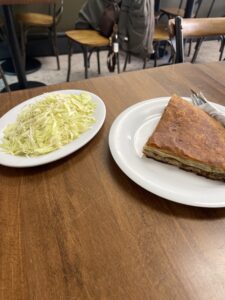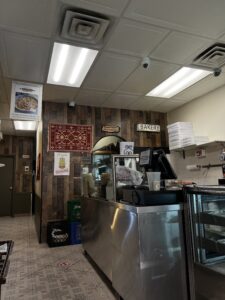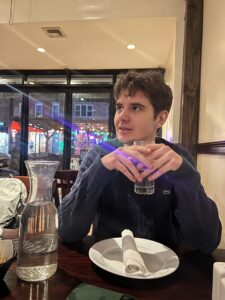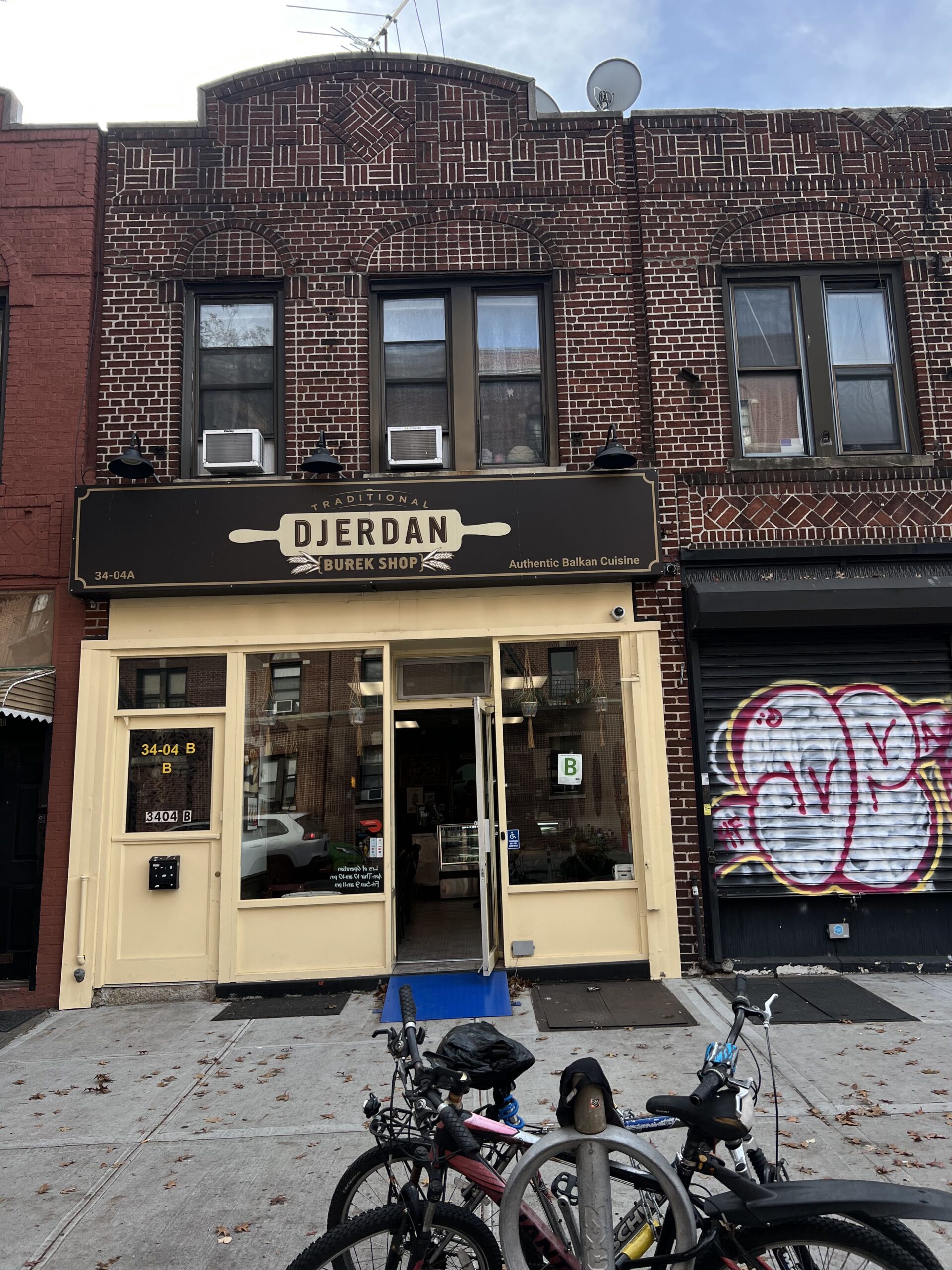We are playing “the Balkan game.”
It’s 7 p.m. and Selo has Oliver Dragojević on, musical hero of the Balkans, while bottles of moonshine rakija clink as they pour.
And yet, the restaurant Selo is quiet enough that our presence in Astoria, Queens, is, with a few stares, decidedly announced. My friend Šime Luznik, a 20-year-old Croatian, is accompanying me, playing the game at our table.
It entails asking our waiter, Mirko, if he knows anyone we know in the Balkans. We will win this round: his hometown, Podgorica, is only 30 minutes from my grandma’s, Tivat, in Montenegro. We do, in fact, know the same guy, Savo, who brews the Podgoričko brand of beer.
Quickly enough, Šime and I each order sarma, a clandestine dish not on the menu. It is widely recognized as the national meal of the Balkans, but somehow, it feels ironic that we’ve ordered it at a restaurant. Traditionally, sarma is served by our moms at home for New Year’s or weddings, after hours of toiling with pickled cabbage leaves.
Ten minutes later, it arrives stunningly plated: two cabbage rolls bursting with meat and rice, resting on a swirling bed of mashed potatoes. On top, in place of the metaphorical cherry, is the smoked piece of rib. This rib is almighty: I cannot count how many times my father and I took my mom’s sarma pot — shaped more like a small tub — and tore into it, searching for those pieces of rib which sink to the bottom and soak in the brine.

Here, there is no work. One for Šime and one for me, spoiled in a restaurant.
The dish, too posh, is the strange reminder that we are not in the homey Balkans.
But it seems that in tonight’s cold rain — on the strip of blocks near 30th Street, not quite empty but not exactly full, in stark contrast to our small and bustling hometowns on the Adriatic Sea — Astoria can be the next-best-thing.
ON OUR BLOCK
“I quite like it here,” Lamija, 26, tells me, gesturing to the seats at Djerdan Burek, and then past it, onto the cracked asphalt street. “But everything’s a far commute.”
Lamija is from Sarajevo, the same city as my father, and, in fact, from the neighborhood Skenderija, next to my family’s zone, Čengić Vila. She came a year ago, and commutes from New Jersey, where she lives with her cousins and some siblings.
“I’m a little lonely for friends,” Lamija admits.
At noon in Djerdan Burek, while construction workers from Albania eat on their lunch break, smoking Marlboro Golds, Lamija slaps together pie boxes. They are not for any New York-style pizza, but for those made Balkan-style, burek, a spiral phyllo-dough pie filled with meat, but also with cheese, spinach, or potatoes.
“The nature of communities in America is different,” she says.
There is no formal ethnic enclave of the Balkans in New York. To walk off the squeaky W train on the Broadway and 31st Street stop and look around does not guarantee an “arrival” anywhere, as Manhattan’s Chinatown or the Bronx’s Little Italy do. In fact, to find Djerdan Burek, it takes me three tries, weaving around the subway platform and tilting my phone until I find the unassuming tan facade, and the roaring silver ovens baking burek inside.
However, there are whispers of what is, by some definition, a “congregation” of Serbs, Croats, Bosnians, and Montenegrins in Astoria. And said “congregation” is found mostly through a network of restaurants, grocers, and what they play, as Balkan culture is tied most directly to food and music. These elements manifest even in the close-by Euromarket, which plays 1980s Yugoslav rock hits and sells staples like Argeta Pašteta pate and Smoki peanut puffs.
While Lamija works, regulars like Vedran, from Belgrade, Serbia, praise the punjene paprike, or stuffed peppers, which he finishes off by licking his knife clean from the potatoes and the rice.
“Whoever survives that meal, he’ll live to tell the tale,” Vedran says.
Despite the presence of traditional dishes, I feel compelled to order burek with meat and a cup of yogurt cultured in-house — a classic mix which is tangy and refreshing, but not heavy on the stomach. I get a cabbage salad (more of a fresh slaw with olive oil and vinegar than a real salad), and finish — after a conversation with Lamija about strolling through Sarajevo’s old town, the Baščaršija — with a slice of Oblanda cake, which layers wafers and chocolate spread.

When I order, I instinctively ask, “I mogu li nešto slatko?” And may I have something sweet?
I don’t know why I say it — somehow a girl-ish thing to say at 20, to ask for permission — but it feels comfortable enough at Djerdan, notably smaller and a little more worn-in than Selo. Soon enough, I spread my notes out on the table, and let a yogurt mustache rest on my upper lip for one-beat-too-long.
“Naravno, bona,” Lamija says (“Of course, babe”), bursting into laughs — the “babe” part said in heavy Sarajevan dialect.
And then she goes back to slamming the pie boxes.
ONE SPOT, FOUR BORDERS
Balkan history is, for many, a symbol of tension. In Astoria, mention of our land invokes its often turbulent history.
“How would you describe our, um, little Balkan ‘village’, since, I dunno, I can’t find a better word?” I ask Snežana on a Tuesday November night at Djerdan Burek that, for however cold and dark it is outside, is busy and bustling.
“Nothing is different at all,” Snežana, 24, says, brushing her hair out of her face. “Enough of that mentality from the Balkans is here. They’re still arguing over who’s a Serb, who’s a Montenegrin, who’s a Croat.”

“Honestly,” Snežava says under her breath, looking up to make sure no one is listening at our corner of Djerdan, which I’d taken to making my regular seat, “here, there’s a lot of that.”
Three decades ago, a war broke out in former Yugoslavia, a failed effort to unite the Balkans under one country. In many ways it is still on the minds of Balkan people, falling into the categories of “survivor” or “product” of the war. My father was a refugee from Bosnia at 21, when the shooting started. My grandparents survived the Siege of Sarajevo, under fire from Serbian sharpshooters from ‘92-’96, for four years without water or electricity. My mom, in Serbia, sat in a basement in Novi Sad, while bombs fell on its bridges. This places me in the category of the “product” faction of the war.
In Astoria, there are no buildings left with bullet holes and grenade shells embedded within their walls, like the pink-tile-roofed buildings of Sarajevo. In this way, Astoria skips the physical scars of conflict.
But search deep enough, and even in New York, the wounds are relentless and inimitable.
THE PRAYER FOR MAGDALENA
Before we go to Djerdan for a Jupi, a quasi-knock-off of Fanta, Šime and I eat at Selo. We start talking to the American couple behind us. The man, Jimmy, is learning our language.
Šime and I usually call it “naš,” a word that literally means “ours,” but can be used in a linguistic reference the way English speakers may call it “Serbo-Croatian,” a method of beelining away from someone announcing their nationality, and an ensuing political debate.
But Jimmy has first learned, it seems, about our war: He insists on us teaching him Serbian, which Šime, in a joke, says neither of us speak. “Technically, I speak Croatian, and she speaks Bosnian,” he laughs, referring to our differing dialects.
Although I’ve only ever perceived those ethnic tensions in the periphery of my life (so many times have I heard my dad quip, “But my wife’s side attacked us first!” at the dinner table), it is in these situations that the tensions truly manifest.
Jimmy throws up a war sign, his fingers fluttering in response.
This restaurant serves Bosnian, Montenegrin, Croatian, and Serbian versions of breakfast, technically all the same meal. It is a reminder that the variation is only in the countries’ names. But we are long used to provocations based on these slight differences that once erupted into war. It is here that we must pretend we are blind.
“When I came here, I really wanted to escape from all our ways of thinking,” Snežana tells me that same night. “We didn’t change at all, even in New York.”
But at Selo, there is also Oliver Dragojević playing, the Croatian singer widely regarded as the great unifier of the Balkans, crooning in radios by the Mediterranean Sea, in the windows of women pinning their clothes up to dry, and in fancy or not-so-fancy restaurants.
In Astoria, it is likely you’ll find yourself in his evergreen presence –– nearly as likely as you would in the Balkans. Šime and I both start to sing along to Molitva za Magdalenu, The Prayer for Mary Magdalene.
“Magdalena, Magdalena… moja patnja, moja tajna, moja ljubav,” we burst into song, laughing. (“Magdalene, Magdalene… my suffering, my secret, my love.”)
It strikes me, only for a moment, that maybe Dragojević is not singing about sainthood at all, but about Balkanhood. Here, that’s formed into Astoriahood, where the genesis of this land exists in equal parts nostalgia and frustration.
But the moment is fleeting, and soon, it is only the music and food which washes over us. Finally, on our block, it is too loud to talk about the past.









